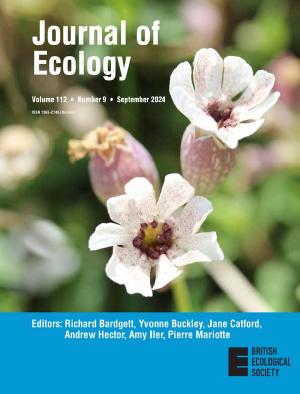-
Partager cette page
Higher abundance of disturbance-favoured trees and shrubs in European temperate woodlands prior to the late-quaternary extinction of megafauna
Co-écrit par Florence Mazier
Publié le 2 octobre 2024 – Mis à jour le 2 octobre 2024

Abstract
1. Large herbivorous mammals strongly influence vegetation structure by creating and maintaining open areas and causing disturbance within closed woody habitats. The herbivores alive today in Europe are only a small remnant of the large species that existed in high diversity and abundance before modern humans. The extinction of so many large herbivores during the last 50,000 years, and the loss of megaherbivores (body weight ≥1000 kg) from most of the continent before the Pleistocene–Holocene transition, is likely to have had cascading effects on vegetation structure and composition.2. To evaluate these effects within the European temperate forest biome, we examine the abundance change of three important European woody taxa (deciduous oaks, Quercus spp.; hazel, Corylus [mainly C. avellana]; and yew, Taxus baccata) before and after the late-Quaternary downgrading of the region''s large herbivore fauna. These taxa are disturbance- avoured, depend on canopy openings for regeneration, and tend to decline in closed dense forests. Quercus and Corylus may thrive in systems affected by megafauna herbivory or fire, whilst Taxus is fire-sensitive but can thrive in grazed systems. Using pollen-based reconstructions (REVEALS), we investigated the proportional cover of these three focal taxa in the Last Interglacial (129,000–116,000 before present [BP]) and early–mid-Holocene (8700–5700 BP).
3. We found that woodlands in the Last Interglacial exhibited higher cover of Corylus and Taxus relative to the Holocene, with the former reaching very high percentage cover; meanwhile, Quercus had a consistent, moderately high percentage cover in both periods. Furthermore, we found that the cover of Corylus and Taxus appeared to be influenced more by unmeasured, non-climatic factors than Quercus.
4. Synthesis: The abundance of Taxus suggests a limited role of fire; whilst the observed levels of Taxus, Corylus and Quercus align with the potential influence of megafauna herbivory; however, a direct quantitative link remains to be established. Our results suggest that vegetation was structurally and compositionally affected by differences in disturbance regimes between the Last Interglacial and early–mid-Holocene, with the loss of diverse disturbance regimes likely contributing to the divergence of Holocene vegetation from long-term ecological baselines.
Lisez l'intégralité de m'article sur le site besjournals.onlinelibrary.wiley.com





